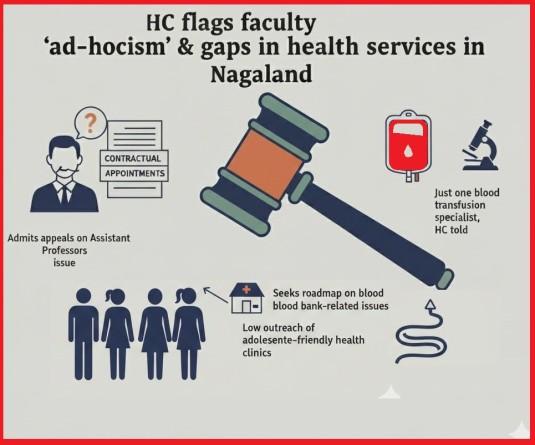
Dimapur, June 27 (MExN): A book on illegal immigration into Nagaland ‘A study into Illegal Immigration into NE India: The case of Nagaland’ has reminded of the serious consequences the state faces if the malady remains ignored by the Naga social organism. The book, published by Associate Professor Dr. M Amarjeet Singh, of National Institute of Advanced Studies, New Delhi says that illegal immigrants have so deeply infiltrated the Naga society that the “hospitality of the Nagas”, coupled with the erosion of community-based values among the contemporary Naga society have only encouraged illegal immigrants to access and control socio-economic and even the socio-political stakes of the Naga people.
“Like elsewhere, estimates about the total population of illegal immigrants in Nagaland are not forthcoming and these estimates vary from 100,000 to 300,000….in 2000, the Union Home Ministry estimated about 75,000 illegal immigrants in the state. In 2003, the Nagaland government estimated approximately one lakh illegal immigrants who had settled in the foothills of the state bordering Assam, “the book states.
One well-known pothole the book reiterated was Bangladesh national have been coming into the state through Assam after obtaining fraudulent Documents (even ration card, voter identity card and driving license, from places like Karimganj, Nagaon, Golaghat and Sibsagar in Assam).
The book also states that in 2003, Nagaland Chief Minister Neiphiu Rio publicly acknowledged that Assam is the ‘exporter’ of illegal immigrants to Nagaland. The Telegraph, a Kolkata-based daily newspaper, also reported that certain officials of the Guwahati Municipal Corporation were issuing birth certificates for a paltry sum of Rs 200.
When Bangladeshis were arrested by the Nagaland Police, Rio alleged according to the book, they produced documents issued by the Assam government to prove their “Indian citizenship.”
Aliens exploiting Nagas’ weaknesses
Professor Dr. Singh pointed out another common Naga blemish: “Prospects for better employment and the dislike of the locals for manual labor have significantly contributed to the influx of immigrants, with the immigrants easily finding work, be it in the agricultural fields, in homes, or as rickshaw pullers and manual laborers. As Nagaland faces a labor shortage, certain sections of Naga society also encouraged immigrants by providing them shelter, land for settlement and cultivation. Local contractors and businessmen also prefer to engage immigrants as they provide cheap and skilled labour.”
In the last two decades (1981-2001), Nagaland recorded the highest population growth in India. Its population growth (Census of India 2001) recorded a sharp rise from 56.08 per cent in 1981-1991 to 64.41 per cent in 1991-2001. The population grew by 5.0 per cent per annum during 1971-81; 5.6 per cent per annum during 1981- 91; and further increased to 6.4 per cent per annum during 1991-2001. Ironically, the population growth has not been uniform; it is concentrated in the plains adjoining Dimapur and districts bordering Assam,” Professor Amarjeet Singh stated.
Most observers attribute this phenomenal increase to illegal immigration, the book stated. Interestingly, all this is happening when the state is supposed to be protected through an ‘Inner-Line Permit system’, which restricts non-locals (Indian citizens from other states) access to most parts of the state.33 My own impression is that the inner-line permit system has not been effective, because it has been severely misused by the local administration, taking small bribes for allowing non-locals to travel, mostly through the Dimapur-Kohima-Imphal section…”
Mixing Naga and “Miya”
Further, the book mentioned the negative impact and hold illegal immigrants are starting to have on the Nagas’ social system: Intermarriage. “…it is even alleged that some Naga girls married immigrants on the impression that the immigrants were hard working,” the book stated while mentioning the name of an allegedly new community of “Naga” people who were half-Naga and half-Miya.
The book then quoted an editorial in a Nagaland newspaper: “There is no denying the fact, that in any Muslim religious day, at least half of the shops in Kohima and some 75 per cent in Dimapur remain closed. The point is that this is a clear indication of how much the migrants have been able to make an impact on trading.” It is also a fact that immigrants, either legal or illegal, are fast gaining access to business establishments across the state; the service industries are now dominated by non-Nagas.
Another consequence illegal immigrants have affected on the state is the criminal activities. The state is not uninformed of the crimes – including rape and murder – committed by aliens even in the very recent times.
The book also extensively quotes local politicians, eminent Naga journalists and Editors as well as government officials. “In a small state like Nagaland, the presence of large number of immigrants is normally perceived as a potential demographic threat. Assuming that there are 1, 00,000 illegal immigrants, several Naga tribes are less populous than the population of illegal immigrants. The unprecedented population growth, more particularly in areas bordering Assam, is believed to be due to their unabated influx. The study also confirmed media reports of intermarriages between the immigrants and the natives.”


.jpg)



